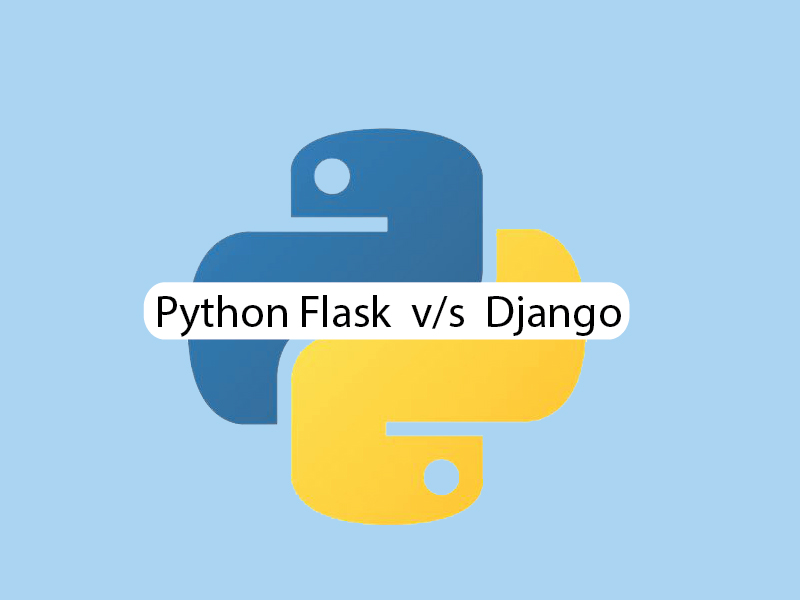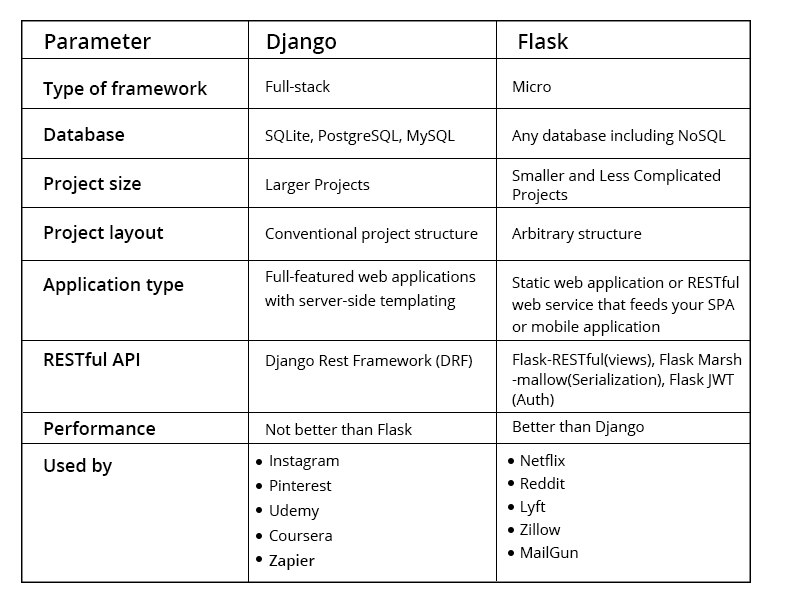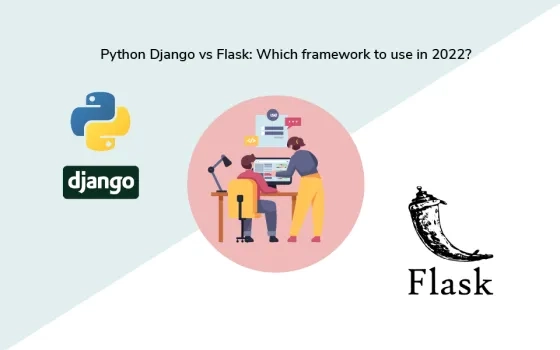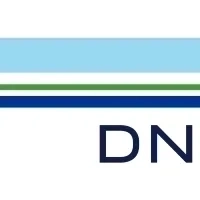If you are into Python development, then you must have heard of two frameworks: Django and Flask. But if you cannot decide which one to choose for your web application, then your confusion will definitely cease after reading this blog on Python Django vs Flask.
Are you really interested to know which framework is better to use for web development, Python Django vs Flask? Numerous Python-based web frameworks allow coders to develop scalable applications swiftly. Out of the many modern choices, Python Django vs Flask are the most talked about frameworks– and essentially because both are alike in some ways and different in many other ways! That leads to a comparison between both, and while each of these web development frameworks has its individual features, there are various factors you should study before picking one for your applications.
Both Django and Flask are hugely famous among offshore Python programmers. Django, on the one hand, is a full-stack web framework for Python development, whereas Flask is a lightweight and extensible Python web framework. Let's learn the core concepts of these two Python frameworks. Flask helps you learn how each component from the back-end works to get a simple web application up and running. Django supports a lot of design patterns, and therefore you learn many exciting concepts. Django is developed based on a batteries-included approach. It allows Python programmers to achieve common web development tasks without employing third-party tools and libraries. Django lacks some of the robust features offered by Python.
Furthermore, both frameworks have extensive community support and documentation, so if you ever come into a problem, it's likely that it's already been addressed and resolved — making your job easier.
Django has been doing wonders since 2005; Flask joined the group of Python frameworks in 2010 – about five years later. No matter what, both are top frameworks in the Python world as of today.
You can go for any of the frameworks if you have a sound knowledge of Python development services. To ease your decision, we have provided a basic overview of both Django and Flask so that you can understand the differences and uses of each in a more useful way.
What is Django?
Django is a full-stack and high-level Python-based web application framework that takes care of many of the standard functionalities to build secure and maintainable websites. Python Django is a free and open-source framework with very active and helpful community support and loads of documentation. This Python framework officially came into existence in July 2005. Python Django development gives you most of the things ‘out-of-the-box’ as one single product. Therefore, there are no integration issues as well.
It promotes speedy development as well as a simple and pragmatic design. Django has been created by a team of experienced and skilled developers and it elegantly handles much of the hassle of Web development. This is done so that you can focus on writing your app without wanting to reinvent the wheel.
Django is a web development framework well known for its batteries-included approach. It means that the Django projects can be delivered faster because the framework offers a lot of features and libraries that decrease coding time.
The Django framework gives a lot more flexibility and focuses on the reusability of components. It allows computational capabilities and RestAPI to build powerful web applications.
Key features of Django

- Versatile framework and can be used for any website with content in any format like HTML, XML, JSON, and more.
- Secure framework; automatically handles standard security features.
- Scalable and maintainable.
- Follows design patterns and principles to reuse and maintain the code.
- Django is portable. It is currently the most popular Python programming language that can run anywhere.
Companies using Django
- Instagram
- Udemy
- Robinhood
- Delivery Hero
- Bepro Company
- Coursera
- Accenture
- YouTube
- Disqus
- Spotify
What is Flask?
Flask is a light-weight WSGI (Web Server Gateway Interface) web application micro-framework which focuses on simplicity and minimal coding. Flask comes with some standard functionalities and allows developers to add any number of extensions for form validation, object relations mapping, uploading mechanism, and much more. Flask is developers’ first choice to add a simple and innovative use case to an existing application as it offers flexibility. Flask is built with a small set of easy-to-learn APIs and the documentation is great. If you have just entered the Python world, begin your web development with Flask, so that you can get the feel of the backend and frontend both as well as understand the core concepts thoroughly.
It is developed and designed to help you get started quickly and easily with web development. Also, it gives the ability to scale up to complex applications. Originally, it started as a mere wrapper around Werkzeug and Jinja and now it has become one of the most popular Python web application frameworks.
In fact, Flask provides more dynamism in development as it enables developers to experiment much better than Django web development with Python.
Key features of Flask

- Gives the developer full control of decisions to build the application during the development stage.
- Comes with a built-in development server as well as a fast debugger
- Coherent and neat API
- Easy and flexible configurations
- RESTful and HTTP request handling
- Integrated Unit testing support
- Werkzeug and Jinja2 are the two main dependencies that provide strong WSGI support and templates, respectively.
Companies using Flask
- Netflix
- Reddit
- Airbnb
- Lyft
- Mozilla
- MIT
- Uber
Python Flask vs Django

- Type of Framework
Django is a Full-stack web framework that follows the batteries-included approach whereas the Flask Light-weight framework has minimalistic features. Django improves custom web application development by offering a built-in template engine, ORM system, and bootstrapping tool. In contrast, Flask is a simple, lightweight, and minimalist web framework. It does not provide built-in features like Django. However, it helps developers in keeping a web application's core basic and extensible.
So, if you're trying to build an application quickly and on a tight schedule, Django might be a good fit. Flask, on the other hand, is ideal for experimenting with and integrating emerging technology.
So, in the contest for the best framework, Django vs Flask, both provide unique features.
- Admin Interface
Django delivers a working admin interface as soon as the application is built. Django also lets you personalize the admin interfaces to meet your own business requirements. It aids in the scaling of your application because it allows you to manage users and content.
Flask, on the other hand, lacks a built-in admin interface. You must incorporate an external tool with which you can perform administrative tasks.
In this Flask vs. Django match, Django stands out in the admin interface.
- Built-in Template Engine
The Django template engine offers you a powerful mini-language for designing your application's user interface. It allows you to separate the HTML/CSS frontend from the backend. Templates are text files that are simple to maintain if you have basic HTML knowledge.
The template engine in Flask is Jinja2. Jinja2 enables you to create many outputs from a single template file. Jinja2 is based on Django's template system.
It contains features like template inheritance and syntax that can be customized. It provides a sandbox in which you may swiftly experiment.
Both template engines are powerful, however, Jinja2 is more flexible and pythonic than Django's template language. You may even use Django to integrate Jinja2.
- Database Support
Django includes an ORM component that allows you to quickly interface with relational databases such as MySQL, SQLite, and Oracle.
The ORM comes with built-in support for database creation and migration. Based on the data models, you may easily design forms and views.
Flask, on the other hand, is easygoing about the data's storage method. Flask has a number of extensions, such as Flask-SQLAlchemy and Flask-Peewee, that allow you to combine your database with Flask.
Django is a suitable option if your data is stored in relational databases. However, if you have unstructured data, Django's built-in ORM will be useless. Flask, on the other hand, allows you to incorporate any database, but you'll have to manage it.
- Performance
You may create a scalable and quick web application using Django. You must optimize the ORM for relational databases, which is built into Django, and query execution is extremely quick. There are also a number of libraries available for Django performance monitoring.
Flask can also process requests at a fast rate and manage numerous requests at the same time. Multiple performance monitoring tools can be added to the flask to monitor and detect whether the application has any bottlenecks.
Flask and Django are used by high-traffic websites, indicating their efficacy and great performance. As a result, there is fierce competition between Flask and Django in terms of speed and performance.
Python Flask vs Django: Comparison

Conclusion:
Who wins in Python Flask vs Django?
This is the developers' all-time question: which framework is better?
Now, you might have got your answer. On the whole, both Python Flask vs Django
are popularly used open-source web frameworks for Python. More than a few basic concepts are the same in both Django and Flask. Hence, the developers must keep in mind the requirements of particular projects while comparing Flask and Django.
To know more about Python Django development or hire Python developers, get in touch with us!




































